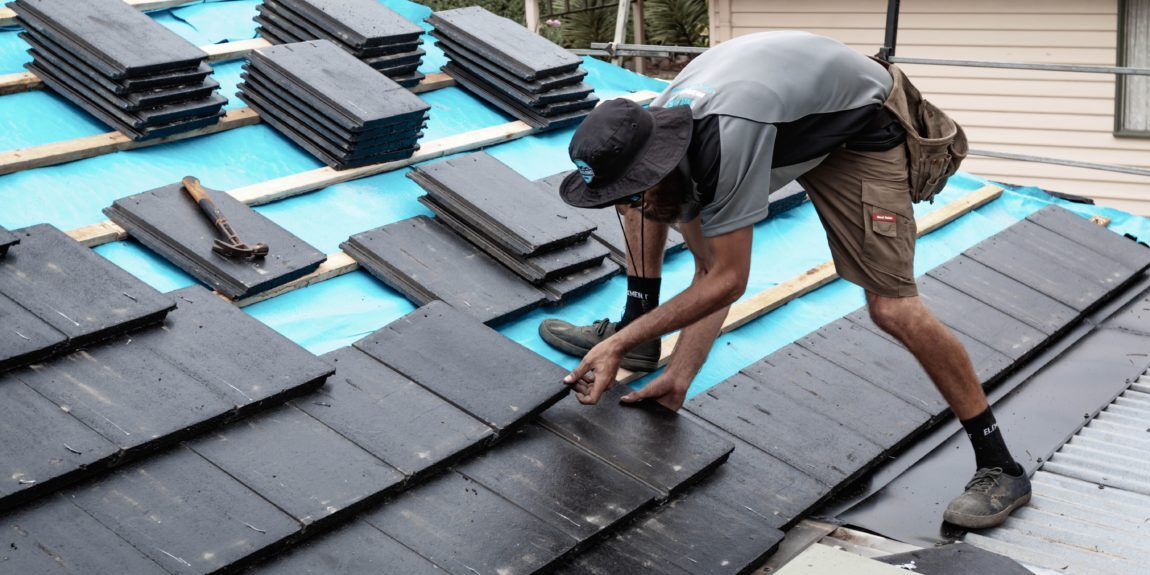When it comes to safeguarding your home, a sturdy and well-maintained roof is your first line of defense. Over time, however, roof tiles can wear out, leading to a myriad of issues. In this comprehensive guide, we’ll delve into the world of roof tile replacement, exploring the signs that indicate it’s time for a change, the various types of roof tiles available, cost considerations, and the crucial steps involved in the replacement process.
Assessing the Need for Replacement
Identifying Cracked or Damaged Tiles
The initial step in understanding whether your roof requires attention is a vigilant inspection. Look out for cracked or damaged tiles, as these are clear indicators of potential problems. If left unattended, these issues could escalate, causing more significant damage to your home.
Checking for Leaks and Water Damage
Water damage is a homeowner’s nightmare, and a compromised roof is a common culprit. Regularly inspect your ceilings and attic for any signs of leaks. These can often be traced back to damaged roof tiles, highlighting the urgency of replacement.
Considering the Age of the Roof
Age matters when it comes to roofs. As your roof ages, the wear and tear on the tiles becomes more apparent. Understanding the lifespan of your roofing material is crucial in determining the optimal time for replacement.
Hiring a Professional Roof Inspector
Benefits of Professional Inspection
While DIY inspections have their place, nothing beats the expertise of a professional. A certified roof inspector can identify subtle issues that might go unnoticed, ensuring a thorough evaluation of your roof’s condition.
Frequency of Roof Inspections
Regular roof inspections should be part of your home maintenance routine. Establishing a schedule, perhaps annually or after severe weather events, can help detect potential problems early on.
Common Issues Detected During Inspections
Roof inspections often reveal common issues such as missing or damaged tiles, issues with flashing, or compromised structural integrity. Addressing these problems promptly can save you from more extensive and expensive repairs down the line.
Types of Roof Tiles
Different Materials Used for Roof Tiles
Roof tiles come in various materials, each with its unique set of characteristics. Common materials include clay, concrete, and slate. Understanding the pros and cons of each can guide your replacement decision.
Pros and Cons of Each Material
Clay tiles offer durability and aesthetic appeal, while concrete tiles provide a more cost-effective alternative. Slate tiles, on the other hand, boast natural beauty and longevity. Consider these factors when choosing the right material for your roof.
Maintenance Requirements
Different materials have distinct maintenance needs. Knowing how to care for your chosen roof tiles can extend their lifespan and minimize the need for premature replacement.
Cost Factors in Roof Tile Replacement
Pricing for Different Types of Tiles
The cost of roof tile replacement varies based on the material you choose. Clay tiles, known for their durability and aesthetic appeal, often come at a higher price point compared to concrete tiles.
Average Labor Costs for Roof Tile Replacement
Labor costs constitute a significant portion of the overall expenses. Understand the average labor costs in your region, and be aware of potential factors that can influence these costs, such as the complexity of the project or local demand for roofing services.
Getting Multiple Quotes for Better Estimates
Don’t settle for the first quote you receive. Reach out to multiple roofing professionals to get a comprehensive understanding of the costs involved. This can help you make an informed decision that aligns with your budget.
DIY vs. Professional Replacement
Risks of DIY Roof Tile Replacement
While the appeal of saving money through a DIY approach is understandable, roof tile replacement is a task best left to professionals. Safety concerns, potential damage to the roof structure, and the risk of voiding warranties make DIY attempts risky.
Benefits of Hiring a Professional
The expertise and experience that professionals bring to the table are unmatched. Hiring a certified roofing contractor not only ensures a job well done but also comes with warranties and guarantees, providing you with peace of mind.
Time and Cost Efficiency
Contrary to popular belief, hiring professionals can be more cost-effective in the long run. Their efficiency in completing the project and the avoidance of potential mistakes can save you both time and money.
Preparing for Roof Tile Replacement
Planning and Scheduling the Project
Timing is crucial when it comes to roof tile replacement. Choose the right season, consider weather conditions, and notify neighbors and local authorities to ensure a smooth process.
Clearing the Roof and Surrounding Area
A clean workspace is essential for a successful replacement project. Prioritize safety measures for workers, protect the landscape and property, and create an environment conducive to efficient work.
Importance of a Clean Workspace
A clutter-free workspace not only facilitates the replacement process but also reduces the risk of accidents. Prioritize clearing the roof and surrounding areas before the project begins.
The Roof Tile Replacement Process
Removing Old or Damaged Tiles
The first step in the replacement process involves safely removing old or damaged tiles. Techniques for safe removal, handling of fragile materials, and proper disposal are crucial considerations.
Repairing Roof Structure
Identifying structural issues during the replacement process is common. Reinforcement and repairs are necessary to ensure a solid foundation for the new tiles and prevent future issues.
Ensuring Watertight Seals
Proper installation techniques are crucial for the longevity of your new roof. Ensuring watertight seals and secure placement of tiles is essential to protect your home from the elements.
Installing New Roof Tiles
Choosing the Right Replacement Tiles
Selecting the right replacement tiles involves matching existing aesthetics, considering upgrades to modern materials, and exploring sustainable and eco-friendly options.
Professional Installation Techniques
Leave the installation to the professionals to guarantee proper alignment, secure placement, and watertight seals. Their expertise ensures the longevity of your new roof.
Sustainable and Eco-Friendly Options
Consider eco-friendly options when selecting new tiles. Sustainable materials not only contribute to environmental conservation but also often come with long-term cost benefits.
Post-Installation Maintenance Tips
Regular Inspections for New Tiles
After the replacement, regular inspections are crucial. Monitor for cracks and damage, clean the roof regularly to prevent debris accumulation, and address any issues promptly to avoid costly repairs.
Extending the Lifespan of Roof Tiles
Applying protective coatings, trimming trees, and considering professional maintenance services can extend the lifespan of your roof tiles. Investing in preventative measures is key to avoiding premature replacement.
Frequently Asked Questions (FAQs)
Q1: How do I know if my roof tiles need replacement?
A: Look out for signs such as cracked or damaged tiles, water leaks, and visible wear. Regular inspections, especially after severe weather events, can help identify potential issues.
Q2: What are the different types of roof tiles available?
A: Roof tiles come in various materials, including clay, concrete, and slate. Each material has its unique characteristics in terms of durability, aesthetics, and maintenance requirements.
Q3: How often should I have my roof inspected?
A: It’s advisable to have your roof inspected at least once a year, and more frequently after severe weather conditions. Professional inspections can catch potential issues early on.
Q4: Can I replace a few damaged tiles myself?
A: While it’s possible to replace a few tiles, a complete roof tile replacement is best left to professionals. DIY attempts can lead to safety hazards, and potential structural damage, and may void warranties.
Q5: How much does roof tile replacement cost?
A: The cost varies depending on factors such as the type of tiles, labor costs, and the extent of the project. Getting multiple quotes from roofing professionals can provide a better estimate.
Q6: Is it possible to upgrade to a different type of roof tile during replacement?
A: Yes, it’s possible to upgrade to a different material during replacement. Consider factors such as durability, aesthetics, and maintenance requirements when making the decision.
Q7: How long does a roof tile replacement project typically take?
A: The duration of the project depends on various factors, including the size of the roof and the extent of damage. A professional roofing contractor can provide a more accurate timeline.
Q8: Can I install solar panels on a roof with replaced tiles?
A: Yes, it’s possible to install solar panels on a roof with replaced tiles. Ensure that the roofing structure is capable of supporting the additional weight, and consult with both roofing and solar professionals.
Q9: How do I maintain my new roof tiles after replacement?
A: Regular inspections, cleaning to prevent debris accumulation, and addressing issues promptly are key to maintaining new roof tiles. Follow any specific maintenance recommendations from the roofing professional.
Q10: Are there eco-friendly options for roof tiles?
A: Yes, there are eco-friendly options, including sustainable materials that are both durable and environmentally friendly. Consider options like recycled content or materials with a low environmental impact.
Conclusion
In conclusion, understanding the intricacies of roof tile replacement is essential for every homeowner. From identifying signs of damage to selecting the right materials and ensuring proper installation, this guide has covered the crucial aspects of the process. Remember, a well-maintained roof not only protects your home but also adds to its aesthetic appeal and value. Prioritize regular inspections, timely replacements, and post-installation maintenance to ensure your roof remains a reliable shield for years to come.







